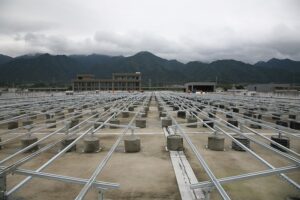
The Clean Energy Transition: Challenges and Opportunities Ahead
The world is at a pivotal moment in its history as it confronts the realities of climate change and the urgent need for a sustainable energy future. The transition from fossil fuels to clean energy sources is a complex and multifaceted challenge that encompasses environmental, economic, and societal dimensions. However, it also presents unprecedented opportunities for innovation, job creation, and the development of resilient communities. This article delves into the critical aspects of the clean energy transition, exploring both the challenges it faces and the opportunities it offers for a sustainable future.
The Need for a Clean Energy Transition
The reliance on fossil fuels, such as coal, oil, and natural gas, has led to significant environmental degradation and climate change. According to the Intergovernmental Panel on Climate Change (IPCC), human activities have contributed to a rise in global temperatures, leading to extreme weather events, sea-level rise, and biodiversity loss. The transition to clean energy sources, including solar, wind, hydro, and geothermal, is essential for reducing greenhouse gas emissions and mitigating the impacts of climate change.
Moreover, the transition supports energy security and economic stability. Many countries are dependent on imported fossil fuels, exposing them to price volatility and supply disruptions. Clean energy sources, in contrast, are often locally available and can decrease dependence on foreign energy supplies. Transitioning to renewable energy can bolster economies by providing new job opportunities and fostering innovation in various sectors.
Challenges in the Clean Energy Transition
Despite its importance, the clean energy transition is fraught with significant challenges. These challenges can be grouped into several key categories: technological, financial, political, and social.
Technological Challenges
One of the primary challenges in the transition to clean energy is the current state of technology. While advances in renewable energy technologies have been impressive, there are still several hurdles that need to be overcome. Energy storage, for instance, is a critical element of renewable energy systems. Solar and wind power are intermittent, meaning that they produce energy only when the sun is shining or the wind is blowing. Developing efficient and cost-effective energy storage solutions, such as batteries, is essential to ensure a stable and reliable energy supply.
Additionally, the integration of renewable energy sources into existing energy grids requires substantial upgrades to infrastructure. Traditional power grids were designed for centralized energy production from fossil fuels, not for the decentralization and variability of renewable sources. Modernizing these systems to accommodate a diverse array of energy inputs will require significant investment and innovation.
Financial Challenges
The financial aspects of the clean energy transition present another significant barrier. While the cost of renewable energy technologies has been decreasing, initial investments for infrastructure and technology development remain substantial. Many countries and communities may struggle to allocate the necessary resources, particularly in developing regions where financial constraints are more pronounced.
Furthermore, existing economic structures often favor fossil fuels, which can lead to an unequal playing field for clean energy investments. Subsidies for fossil fuels can distort market conditions, hindering the growth of renewable energy industries. Transitioning away from these entrenched systems requires careful policy and economic frameworks to encourage fair competition and investment in clean technologies.
Political Challenges
The political landscape significantly impacts the pace and effectiveness of the clean energy transition. Policymakers face pressure from various stakeholders, including industry lobbyists, labor groups, and the general public, which can complicate decision-making. In many cases, there is a lack of long-term commitment to clean energy policies, as administrations change and priorities shift. This political instability can create uncertainty for investors and delay the development of clean energy projects.
International cooperation is also essential in addressing climate change. However, geopolitical conflicts and differing national interests can impede collaborative efforts in transitioning towards clean energy. Global agreements and frameworks, such as the Paris Agreement, require nations to commit to specific targets, yet achieving consensus on such issues can be difficult.
Social Challenges
The societal implications of a clean energy transition cannot be overlooked. Many communities, particularly those reliant on fossil fuel industries, may face significant job losses as the world moves towards renewable energy. This can lead to resistance against clean energy initiatives and an increase in social inequalities if adequate measures are not put in place.
Public awareness and acceptance of clean energy technologies also pose a challenge. Misunderstandings about renewable energy, including concerns about reliability and environmental impacts, can hinder progress. Engaging communities and building support for clean energy initiatives through education and outreach is crucial for fostering a positive public perception and encouraging participatory governance.
Opportunities in the Clean Energy Transition
Despite these challenges, the transition to clean energy offers a wealth of opportunities that can transform economies, enhance energy security, and benefit society at large. Among the key opportunities are economic growth, job creation, technological innovation, and improved public health.
Economic Growth
The transition to clean energy presents an immense opportunity for economic growth. According to the International Renewable Energy Agency (IRENA), the global renewable energy sector could create millions of new jobs by 2050. These jobs can span a wide range of activities, from manufacturing solar panels to installing wind turbines and maintaining renewable energy systems. Cultivating a skilled workforce in these fields can lead to sustainable economic development, particularly in regions seeking to diversify their economies.
Investment in clean energy technologies can stimulate local economies and reduce reliance on fossil fuel imports. Renewables can also lessen the volatility of energy prices and enhance energy independence, leading to more stable economic conditions. As innovations continue to emerge in the clean energy sector, new markets and business models will evolve, providing additional opportunities for entrepreneurs and established companies alike.
Job Creation
The transition to clean energy has the potential to create a vast number of new jobs across various sectors. While some jobs in fossil fuel industries may be lost, many more will be created in renewable energy, energy efficiency, and related fields. For instance, the solar and wind industries are already experiencing significant growth, creating jobs in manufacturing, installation, and maintenance.
Additionally, as energy efficiency measures become more prevalent, there will be increased demand for skilled workers in retrofitting buildings and improving energy systems. These new jobs often offer higher wages and better working conditions, contributing to overall economic well-being.
Technological Innovation
Innovation is a cornerstone of the clean energy transition. The pursuit of more efficient, cost-effective renewable energy technologies has the potential to spur advances not only within the energy sector but also in related fields, such as transportation, agriculture, and manufacturing. For instance, electric vehicles (EVs) represent a significant opportunity to reduce greenhouse gas emissions in the transportation sector while promoting the development of smart grid technologies that better integrate renewable energy sources.
Investment in research and development can lead to breakthroughs that significantly enhance the performance and affordability of renewable technologies. Furthermore, flexible and digitalized energy systems can create a resilient and adaptive infrastructure capable of meeting the energy demands of the future. By nurturing a culture of innovation, societies can unlock the full potential of clean energy solutions.
Improved Public Health
Transitioning to clean energy sources can greatly improve public health by reducing air and water pollution associated with fossil fuel extraction and combustion. Cleaner air quality results in fewer respiratory diseases, cardiovascular issues, and other health problems linked to pollution. As communities adopt renewable energy technologies, they can foster healthier environments that contribute to overall well-being and reduce healthcare costs associated with pollution-related illnesses.
Moreover, energy efficiency measures in buildings and transportation can reduce energy consumption, leading to lower utility bills for households and businesses. This, in turn, can help alleviate energy poverty and enhance the quality of life for vulnerable populations.
Strategies for a Successful Clean Energy Transition
To harness the opportunities presented by the clean energy transition while addressing the associated challenges, a multifaceted approach is required. Successful strategies will include policy frameworks, technological investments, workforce development, and community engagement.
Policy Frameworks
Governments play a crucial role in facilitating the clean energy transition. Developing comprehensive policies that support renewable energy deployment, incentivize innovation, and phase out fossil fuel subsidies can create a conducive environment for investment and growth. Clear and consistent policy signals will help both private and public sectors align their efforts toward common goals, enhancing the effectiveness of the transition.
Additionally, international cooperation is vital for addressing global climate change challenges. Countries must work together to share best practices, develop joint initiatives, and mobilize resources to support clean energy projects in developing regions, ensuring a more equitable transition on a global scale.
Technological Investment
Investment in clean energy technologies is essential to drive the transition forward. Governments, private investors, and financial institutions should prioritize funding for research and development in renewable energy, energy storage, and smart grid technologies. Collaboration between academic institutions, industry leaders, and policymakers can lead to innovative solutions that accelerate the transition while enhancing economic efficiency.
Workforce Development
Building a workforce capable of supporting the clean energy transition requires targeted education and training programs. Investments in vocational education, apprenticeship programs, and reskilling initiatives can equip workers with the necessary skills to thrive in the renewable energy sector. Collaboration between industry and educational institutions can help align training programs with evolving market needs, ensuring a well-prepared workforce.
Community Engagement
Engaging communities in the clean energy transition is critical to fostering support and ensuring equitable outcomes. Policymakers and energy companies should prioritize transparency and collaboration with local communities, allowing residents to voice their concerns and aspirations. Public outreach and education initiatives can help demystify clean energy technologies, promote awareness of their benefits, and build public confidence in the transition.
Conclusion
The clean energy transition is both a challenge and an opportunity. While the obstacles are significant, they are not insurmountable. By embracing innovation, investing in technologies, prioritizing policy coherence, and engaging communities, society can navigate the complex landscape of the clean energy transition. Ultimately, the successful shift toward renewable energy sources holds the promise of a more sustainable, equitable, and prosperous future for generations to come.



